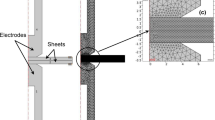Abstract
During the sheet metal forming, one of the major causes for die failure is transfer and accumulation of adhered material to the die surface, generally referred to as galling behavior. In the present work, the galling mechanism in sheet metal forming is investigated by a multi-scale approach. Firstly, the macro-galling behavior in square cup drawing of high-strength steel is examined by laboratory experiment and numerical simulation. Then, the first-principle calculations are used to present an insight to the atomic level galling at TiC/bcc-Fe interface. As a result, the macro-galling behavior in sheet metal forming is dominated by the critical contact pressure and the effective sliding distance. At atomic scale, the theoretical modeling using perfect crystals suggests that the separation most likely occurs at TiC/bcc-Fe interface or within the sub Fe slab, where the initiation galling would be arose and then formed as micro-adhesion.
Similar content being viewed by others
References
Fan DW, Kim HS, De Cooman BC (2009) A review of the physical metallurgy related to the hot press forming of advanced high strength steel. Steel Res Int 80(3):241–248
Kim H, Sung JH, Goodwin FE, Altan T (2008) Investigation of galling in forming galvanized advanced high strength steels (AHSSs) using the twist compression test (TCT). J Mater Process Technol 205(1):459–468
Yan W Y, E.P. Bus so E P, O’Dowd N P (2002) A micromechanics investigation of sliding wear in coated components. Proc R Soc A: Math, Phys Eng Sci 456:2387–2407
Yan WY (2006) Theoretical investigation of wear-resistance mechanism of superelastic shape memory alloy NiTi. Mater Sci Eng A 427(1):34–355
Jensen MR, Damborg FF, Nielsen KB, Danckert J (1998) Applying the finite-element method for determination of tool wear in conventional deep-drawing. J Mater Process Technol 83(1):98–105
Pereira MP, Yan WY, Rolfe BF (2008) Contact pressure evolution and its relation to wear in sheet metal forming. Wear 265(11):1687–1699
Pereira MP, Yan W, Rolfe BF (2010) Sliding distance, contact pressure and wear in sheet metal stam**. Wear 268(11):1275–1284
Pereira MP, Rolfe BF (2014) Temperature conditions during ‘cold’ sheet metal stam**. J Mater Process Technol 214(8):1749–1758
Okonkwo PC, Kelly G, Rolfe BF, Pereira MP (2012) The effect of temperature on sliding wear of steel-tool steel pairs. Wear 282:22–30
Manohara HR, Chandrashekharaiah TM, Venkateswarlu K, Kori SA (2013) Sliding wear performance of reinforced A413 alloy at elevated temperatures. Int J Adv Manuf Technol 65(1):395–402
Menezes PL, Kishore KSV (2009) Influence of roughness parameters and surface texture on friction during sliding of pure lead over 080 M40 steel. Int J Adv Manuf Technol 43(7):731–743
Lin SY (1999) Investigation of die-workpiece interface friction with lubrication during the upsetting process. Int J Adv Manuf Technol 15(9):666–673
Yu XG, Jiang ZG, Zhao JG, Wei DB, Zhou CL, Huang QG (2015) Effects of grain boundaries in oxide scale on tribological properties of nanoparticles lubrication. Wear 332–333:1286–1292
Hol J, Cid Alfaro MV, de Rooij MB, Meinders T (2012) Advanced friction modeling for sheet metal forming. Wear 286–287:66–78
Klocke F, Trauth D, Shirobokov A, Mattfeld P (2015) FE-analysis and in situ visualization of pressure-, slip-rate-, and temperature-dependent coefficients of friction for advanced sheet metal forming: development of a novel coupled user subroutine for shell and continuum discretization. Int J Adv Manuf Technol 81(1):397–410
Hou YK, Zhang WG, Yu ZQ, Li SH (2009) Selection of tool materials and surface treatments for improved galling performance in sheet metal forming. Int J Adv Manuf Technol 43(9):1010–1017
Gaard A, Krakhmalev P, Bergstrom J (2009) Influence of tool steel microstructure on origin of galling initiation and wear mechanisms under dry sliding against a carbon steel sheet. Wear 267(1):387–393
Van der Heide E, Schipper DJ (2003) Galling initiation due to frictional heating. Wear 254(11):1127–1133
Dong WZ, Lin QQ, Wang ZG (2015) On the galling behavior in HSS sheet metal forming process by FEM-Archard model. Mater Sci Technol 23(3):35–38 (in Chinese)
Archard JF (1953) Contact and rubbing of flat surfaces. J Appl Phys 24(8):981–988
Panjan P, Bonina I, Bevk J, Cekada M (2005) PVD hard coatings applied for the wear protection of drawing dies. Surf Coat Technol 200(1-4):133–136
Vitos L (2001) Total-energy method based on the exact muffin-tin orbitals theory. Phys Rev B 64(1):1–11
Dunand A, Flack HD, Yvon K (1985) Bonding study of TiC and TiN. I. high-precision x-ray-diffraction determination of the valence-electron density distribution, Debye-Wailer temperature factors, and atomic static displacements in TiC0.94 and TiN0.99. Phys Rev B 31(4):2299–2315
Author information
Authors and Affiliations
Corresponding author
Rights and permissions
About this article
Cite this article
Dong, W., Xu, L., Lin, Q. et al. Experimental and numerical investigation on galling behavior in sheet metal forming process. Int J Adv Manuf Technol 88, 1101–1109 (2017). https://doi.org/10.1007/s00170-016-8843-6
Received:
Accepted:
Published:
Issue Date:
DOI: https://doi.org/10.1007/s00170-016-8843-6




